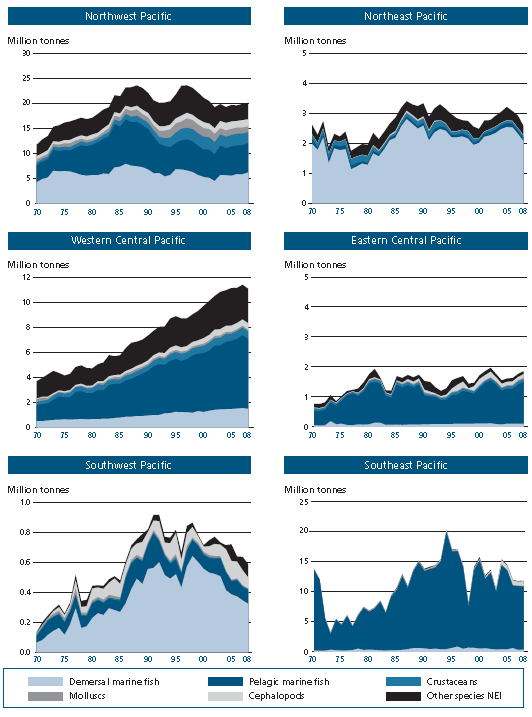Graph of the Day: Capture Fisheries Production in the Pacific Ocean, 1970-2008
Note: NEI = not elsewhere included. In the Northwest Pacific, small pelagics are the most abundant category, with Japanese anchovy providing about 1.9 million tonnes in 2003, but having since declined to 1.2 million tonnes in 2008. Other important contributors to the total catch in the area are the largehead hairtail, considered overexploited, and the Alaska pollock and chub mackerel, both considered fully exploited. Squids, cuttlefish and octopuses are important species, yielding 1.4 million tonnes. In the Eastern Central and Southeast Pacific, there have been no major changes in the state of stock exploitation, while there have been some improvements regarding the assessment and management of some key fish stocks at both the national and international levels. Regarding international cooperation, after 3–4 years of intense negotiations, some of the member parties of the proposed South Pacific Regional Fisheries Management Organization (Chile, Colombia, Cook Islands, New Zealand and Peru) adopted the Convention on the Conservation and Management of the High Seas Fishery Resources of the South Pacific Ocean, in Auckland, New Zealand, on 14 November 2009. This convention promotes the international conservation and management of non-highly-migratory fisheries and protection of biodiversity in the area extending from the easternmost part of the South Indian Ocean through the Pacific towards the EEZs of South America. Central American countries have also improved regional cooperation for the assessment and management of important coastal fisheries resources in their area. In addition, a moderate El Niño developed in 2009 and continued throughout the equatorial Pacific in the early months of 2010. Deep tropical convection remained enhanced across central and eastern parts of the tropical Pacific, with relatively mild impacts reported on the state of stocks and fisheries in the eastern Pacific. Total production in the Western Central Pacific grew continuously to a maximum of 11.4 million tonnes in 2007 and then decreased slightly in 2008. This area contributes about 14 percent of global marine production. Despite this apparently positive situation, there are reasons for concern regarding the state of the resources, with most stocks being either fully exploited or overexploited (many also depleted), particularly in the western part of the South China Sea. The high catches have probably been maintained through expansion of the fisheries to new areas, and possible double counting in the transshipment of catches between fishing areas, which leads to bias in estimates of production, potentially masking negative trends in stock status.
The State of World Fisheries and Aquaculture 2010 [pdf], FAO Fisheries and Aquaculture Department, FOOD AND AGRICULTURE ORGANIZATION OF THE UNITED NATIONS, Rome, 2010
